Imagine you're gearing up for a weekend ride, only to discover your tire's worn down to the threads. This scenario underscores the importance of having a thorough motorcycle maintenance checklist. You might think you can skip some of these checks, but overlooking even minor details can lead to serious issues on the road. So, what should you prioritize to guarantee your bike runs smoothly and safely? Let's explore the essentials that every rider should include in their maintenance routine.
Quick Takeaways
- Regularly check tire pressure, tread depth, and inspect for visible damage to ensure optimal grip and handling.
- Inspect brake pads, fluid levels, and system for leaks to maintain effective braking performance.
- Change engine oil and filter every 3,000 to 5,000 miles to ensure smooth engine operation and prevent damage.
- Examine battery terminals for corrosion, test charge levels, and maintain fluid to ensure reliable starting and performance.
Importance of Regular Maintenance
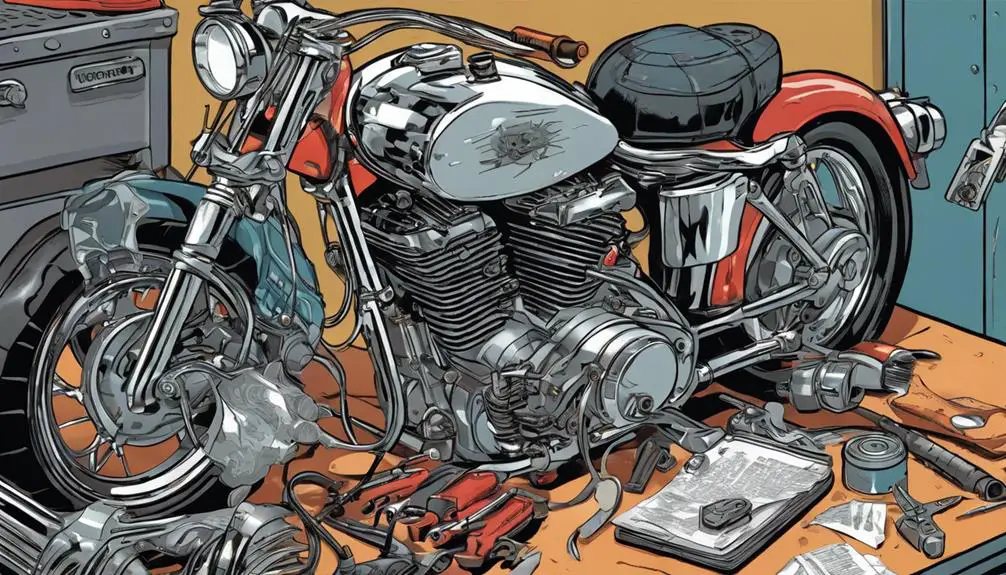
Regular maintenance is essential for keeping your motorcycle running smoothly and extending its lifespan. It's not just about the thrill of the ride; it's about ensuring your freedom on two wheels. When you regularly check your bike, you're actively protecting your investment and enhancing your experience. Ignoring maintenance can lead to unexpected breakdowns, which can strip away your freedom and joy.
You'll want to inspect critical components like brakes, tires, and fluids. A well-maintained motorcycle responds better, allowing you to maneuver with confidence. Think about how liberating it feels to ride without worry, knowing your machine is in top shape. Plus, regular maintenance can prevent costly repairs down the line.
Embrace the responsibility of upkeep, and you'll find that it deepens your connection to your bike. It's about being proactive and ensuring that every journey isn't just safe but exhilarating. So, take charge! Your motorcycle deserves your attention, and you deserve the peace of mind that comes with a reliable ride.
Regular maintenance is your ticket to freedom on the open road. Don't just ride—thrive!
Essential Tools for Maintenance
What tools do you need to keep your motorcycle in top condition? First, invest in a quality set of wrenches and sockets. These are important for tightening bolts and making adjustments. A torque wrench is also a must-have; it guarantees you're applying the right amount of pressure without damaging your bike.
Next, grab a set of screwdrivers. Flathead and Phillips screwdrivers will help you tackle various tasks, from changing your battery to adjusting your mirrors. Don't forget pliers—they're perfect for gripping and bending cables or wires.
A chain tool is essential if you've got a chain-driven bike. It'll help you maintain or replace your chain with ease. Additionally, a tire pressure gauge is significant; keeping your tires properly inflated enhances your ride's performance and safety.
Lastly, consider a motorcycle jack to lift your bike for maintenance. This tool makes it easier to access hard-to-reach areas.
With these important tools in your arsenal, you'll empower yourself to perform routine maintenance and enjoy the freedom of the open road, knowing your motorcycle's in great shape.
Pre-Ride Inspection Checklist
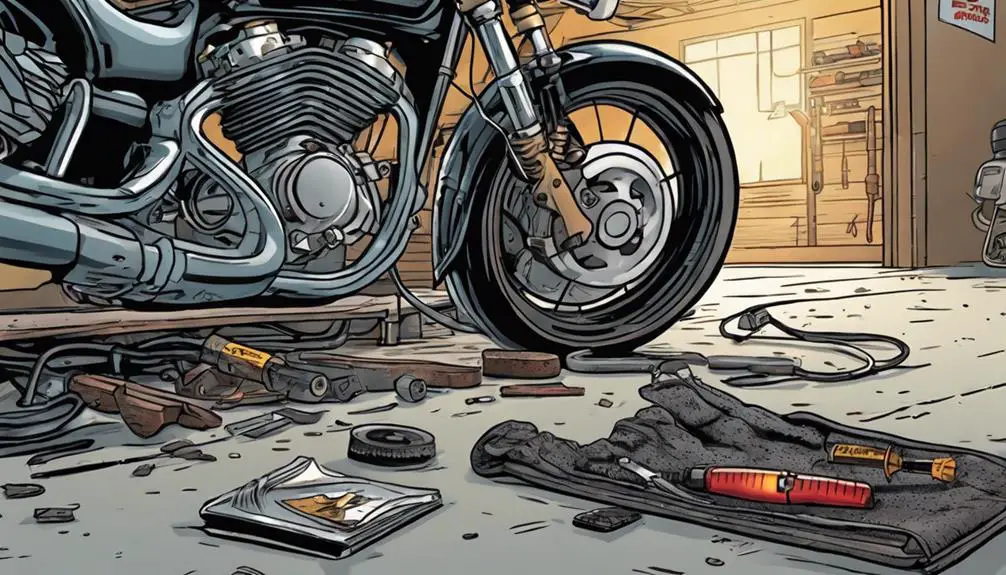
Having the right tools prepares you for maintenance, but a pre-ride inspection checklist guarantees your motorcycle is safe and ready for the road.
Before you rev up and chase the horizon, take a moment to verify everything's in tip-top shape. Start by checking your tires for proper inflation and tread wear; they're your only contact with the asphalt.
Next, inspect the brakes—grab the lever and feel for responsiveness. Trust me, you want to know they'll stop you when needed.
Don't forget about the lights. Turn on your headlights, brake lights, and turn signals to verify visibility.
A quick glance at your fluid levels—brake, coolant, and fuel—can save you from an unexpected breakdown. While you're at it, check your chain or belt for tension and lubrication; a smooth ride begins with a well-maintained drive system.
Lastly, give your bike a once-over for any loose bolts or signs of wear. A few minutes of inspection can lead to countless miles of freedom.
Engine Oil and Filter Change
Changing your engine oil and filter regularly is essential for keeping your motorcycle running smoothly.
You'll want to choose the right oil to match your bike's needs and guarantee peak performance.
Let's explore why these changes are important and how to pick the best oil for your ride.
Importance of Regular Changes
Regularly changing your engine oil and filter is essential for keeping your motorcycle running smoothly and efficiently. When you ride, your engine faces intense heat and friction, which can break down the oil's protective qualities over time. Old oil loses its ability to lubricate, leading to increased wear on engine components. You don't want to be weighed down by the fear of mechanical failure on the open road.
Changing your oil and filter not only enhances performance but also maximizes the lifespan of your bike. Fresh oil helps maintain ideal engine temperature and keeps harmful contaminants at bay. Think of it as giving your motorcycle the freedom to unleash its full potential, allowing you to embrace the ride with confidence.
Plus, this simple maintenance task can save you money in the long run. By preventing significant engine damage, you can avoid costly repairs that might tether your adventures. So, don't wait until you notice issues; make it a habit. Embrace the liberation that comes with knowing your bike is in peak condition, ready to take you wherever the road leads.
Keep your engine healthy, and let the journey unfold!
Choosing the Right Oil
Choosing the right oil for your motorcycle is essential for ideal engine performance and longevity. You want your ride to feel free and powerful, and the right engine oil helps accomplish that. Start by checking your owner's manual; it'll specify the type and viscosity of oil that suits your bike best.
Consider whether you're using synthetic or conventional oil. Synthetic oils often provide better lubrication and protection, especially if you're pushing your bike to its limits. Look for oils that meet the API (American Petroleum Institute) standards to guarantee quality.
When it comes to changing your oil, don't forget the oil filter. A clean filter keeps contaminants at bay, allowing your engine to breathe easier and perform better. You want to change both the oil and filter regularly—typically every 3,000 to 5,000 miles, but check your manual for specifics.
Tire Maintenance and Inspection
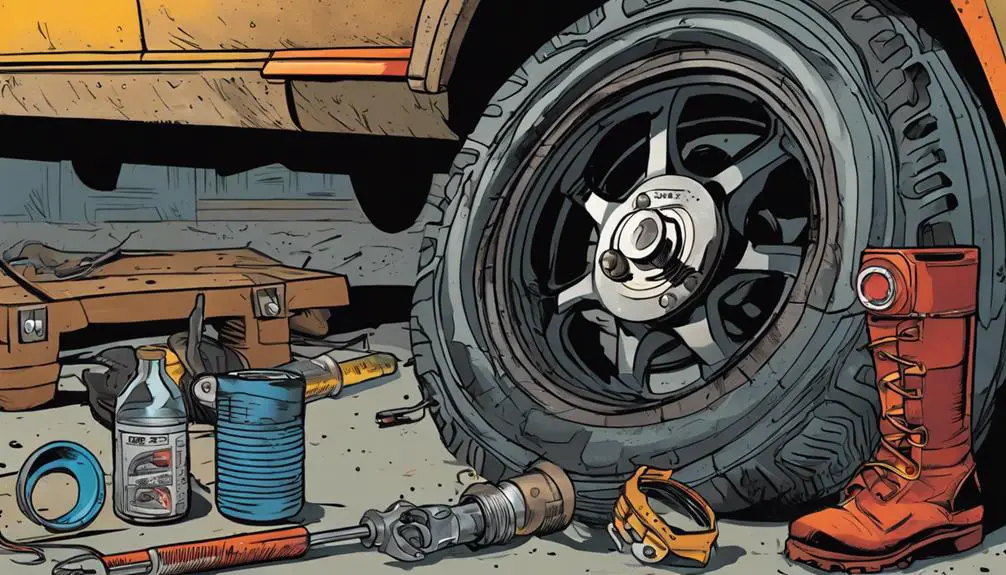
Keeping your tires in top shape is crucial for safe and enjoyable rides. Start by checking tire pressure regularly; under-inflated or over-inflated tires can lead to poor handling and increased wear. Use a reliable gauge and adjust the pressure according to your motorcycle's specifications.
Next, inspect the tread depth. Worn tires can compromise your grip, especially in wet conditions. A simple way to measure is by using the penny test—insert a penny into the tread; if you can see all of Lincoln's head, it's time for new tires.
Look for any visible damage, like cuts, cracks, or bulges. These can lead to blowouts, so don't ignore them. Also, check for uneven wear; it can indicate alignment or suspension issues.
Lastly, rotate your tires as recommended to promote even wear. It's your freedom on the open road, and taking care of your tires guarantees you can enjoy every twist and turn.
Keeping them maintained not only enhances performance but also boosts your confidence as you ride into the horizon. So, get out there and embrace the adventure—your tires are your connection to the freedom of the ride!
Brake System Check
When it comes to safety, checking your brake system is essential.
You'll want to inspect the brake pads for wear and guarantee the brake fluid is at the proper level.
Regular maintenance here can help prevent issues down the road.
Inspect Brake Pads
Inspecting your brake pads regularly guarantees ideal braking performance and safety on the road. As a rider, your freedom depends on your bike's ability to stop when you need it to.
Start by checking the thickness of your brake pads; they should be at least 1/8 inch thick. If they're worn down, it's time for a replacement.
Next, look for any uneven wear, which can indicate issues with your brake calipers or alignment. Make sure there's no cracking or debris lodged in the pads; these can compromise your braking power.
Don't forget to inspect the rotor surface, too. It should be smooth and free of grooves.
While you're at it, listen for any unusual sounds when you brake. Squeaking or grinding can signal worn pads or more serious problems.
Regular inspections not only enhance your safety but also prolong the lifespan of your brake system, keeping your ride smooth and liberating.
Check Brake Fluid
Regularly checking your brake fluid is essential for maintaining ideal braking performance and ensuring your safety on the road. Your brake system relies on hydraulic pressure, and low or contaminated fluid can lead to diminished control.
Start by locating the brake fluid reservoir, usually situated near the handlebars or on the rear brake assembly. Inspect the fluid level; it should sit between the minimum and maximum marks. If it's low, top it off with the manufacturer-recommended fluid.
Don't just add fluid; check for leaks in the system too, as they can indicate a more serious issue.
Next, examine the fluid's color. Fresh brake fluid is typically clear or light amber, while dark, murky fluid signals contamination. If it looks off, it's time for a complete flush and replacement.
Battery Care and Maintenance
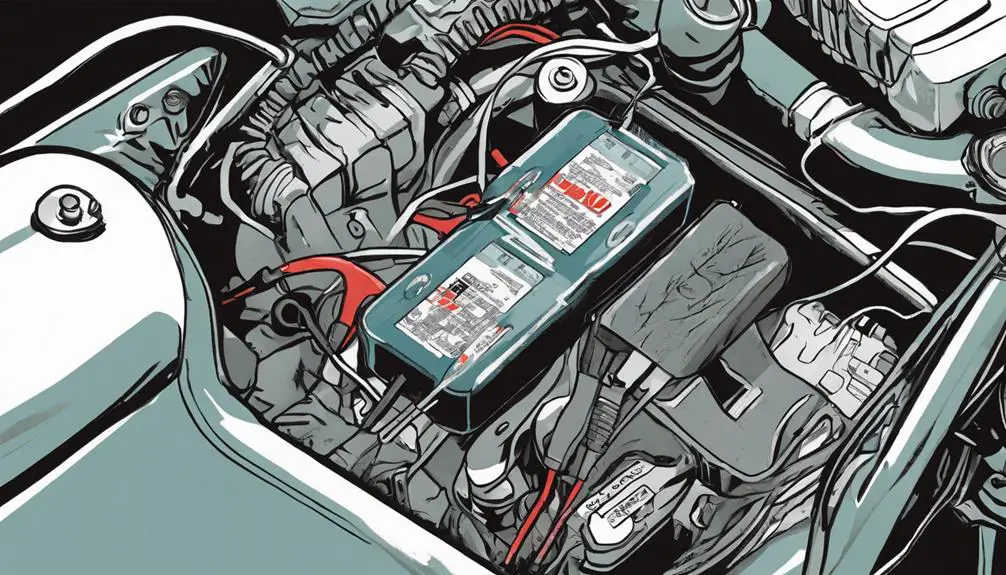
Proper battery care is essential for ensuring your motorcycle starts reliably and performs efficiently.
Start by checking the battery terminals for corrosion. Clean them with a mixture of baking soda and water, using a wire brush or cloth. A clean connection helps maintain a strong electrical flow, keeping your bike ready to ride.
Next, inspect the battery fluid levels. If your battery has removable caps, peek inside to see if the fluid covers the lead plates. If it's low, refill with distilled water. Avoid overfilling, as the acid can spill out during charging.
Keep an eye on the battery's charge. Regularly test it with a multimeter or a dedicated battery tester. If the voltage drops below 12.4 volts, it's time to charge it. Use a smart charger that can prevent overcharging, extending your battery's life.
Lastly, consider investing in a battery maintainer if you store your bike for long periods. This will keep the battery topped off, ensuring it's ready when you are.
Embrace these maintenance habits, and you'll ride freely, knowing your motorcycle's heart is in top shape.
Chain and Sprocket Inspection
After ensuring your battery's in good shape, it's time to check the chain and sprockets for wear and proper tension. This inspection is essential for a smooth ride and can prevent costly repairs down the road. You want to feel that freedom on the open road, and a well-maintained chain is key to that experience.
Here's what to look for during your inspection:
- Chain Tension: Make sure the chain isn't too loose or too tight. It should have a little slack, allowing for smooth operation.
- Wear and Tear: Look for signs of wear, such as stiff links or rust. A worn chain can lead to poor performance and can damage your sprockets.
Common Suzuki Issues to Watch For
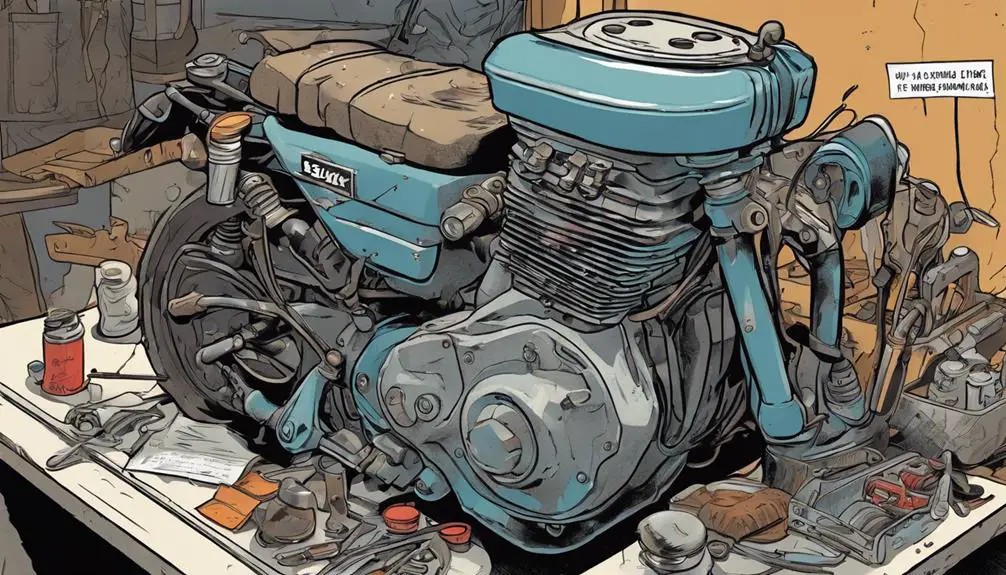
When owning a Suzuki, it's important to stay alert for common issues that could affect performance and safety. One major concern is oil leaks, often stemming from gaskets or seals that wear out over time. If you notice any spots under your bike, investigate right away to prevent further damage.
Another issue to keep an eye on is the electrical system. Suzuki models can experience problems with the battery and wiring, leading to starting issues or electrical failures. Regularly check your battery connections and inspect wiring for frays or corrosion.
Brake performance is crucial for your freedom on the road. Be mindful of any unusual noises or a spongy feel in the brake lever, which could indicate worn brake pads or air in the lines. Address these concerns promptly to guarantee your ride remains safe.
Common Questions
How Often Should I Perform a Full Motorcycle Maintenance Check?
You should perform a full motorcycle maintenance check at least once a season, or every 3,000 to 5,000 miles, whichever comes first. This guarantees your ride stays in top condition and keeps you safe on the open road.
Don't ignore any unusual sounds or performance issues—tend to them right away. Embracing this routine not only enhances your motorcycle's longevity but also allows you to enjoy your freedom with confidence.
Can I Use Car Oil for My Motorcycle?
You know the saying, 'You get what you pay for.'
Using car oil in your motorcycle isn't the best choice, as it might lack the specific additives your bike needs.
Motorcycle engines operate differently and require oil that can handle higher RPMs and heat.
Stick to the oil designed for motorcycles to keep your ride smooth and powerful.
Embrace the freedom of the open road by taking care of your machine!
What Are Signs My Motorcycle Needs Professional Servicing?
If you're wondering whether your motorcycle needs professional servicing, pay attention to signs like strange noises, difficulty starting, or a drop in performance.
You might notice leaks or an unusual smell, which could indicate deeper issues.
If your brakes feel less responsive or your tires show uneven wear, it's time to get expert help.
Trust your instincts; keeping your ride in top shape means more freedom on the road!
Is Winter Storage Necessary for Motorcycles?
Yes, winter storage's essential for your motorcycle.
When temperatures drop, moisture can cause rust and damage to your bike. By storing it indoors, you protect it from harsh elements like snow and ice.
You should also maintain the battery and fluids to keep everything in top shape.
Taking these steps guarantees your ride's ready when the warm weather returns, allowing you to hit the road without hassle or worry.
How Can I Prolong the Life of My Motorcycle Tires?
To prolong the life of your motorcycle tires, keep 'em properly inflated and check the pressure regularly.
Rotate your tires to guarantee even wear and avoid aggressive riding.
Regularly inspect for any damage or foreign objects lodged in the tread.
Store your bike in a cool, dry place, away from direct sunlight, to prevent premature aging.
Finally, consider using tire conditioners to maintain flexibility and protect against cracking.
Your ride deserves the best!
Wrapping Up
In the thrill of the ride, don't overlook the quiet necessity of maintenance.
While the open road calls, a well-cared-for motorcycle responds with reliability and performance.
By following this checklist, you balance excitement with safety, ensuring every journey is both exhilarating and secure.
Just as you trust your bike to carry you through every twist and turn, trust the routine checks to keep it running smoothly.
After all, a little effort now can lead to countless adventures ahead.